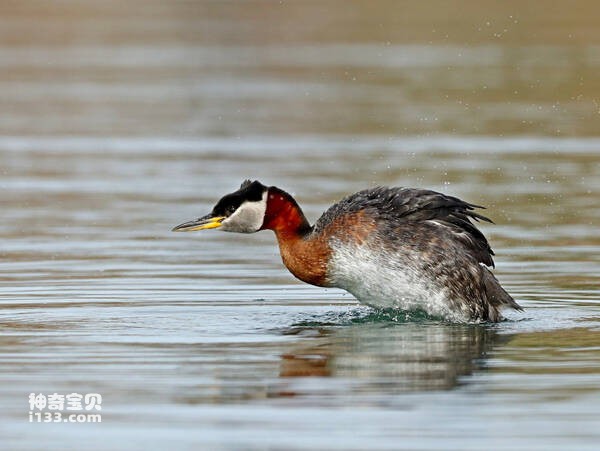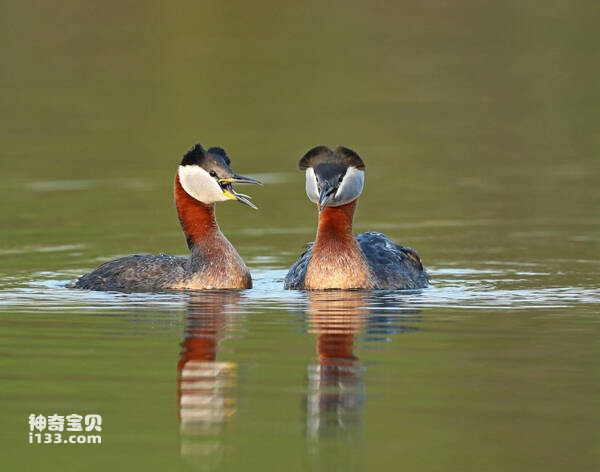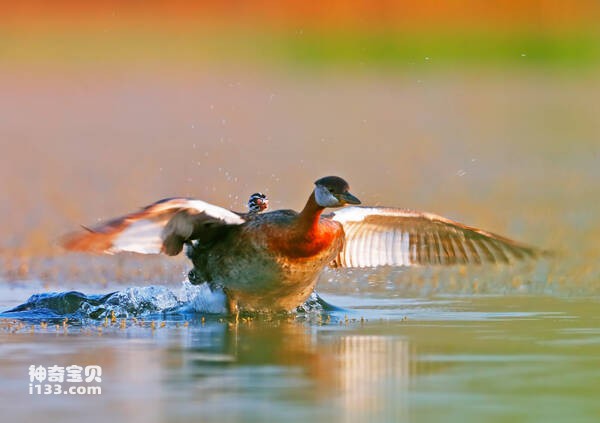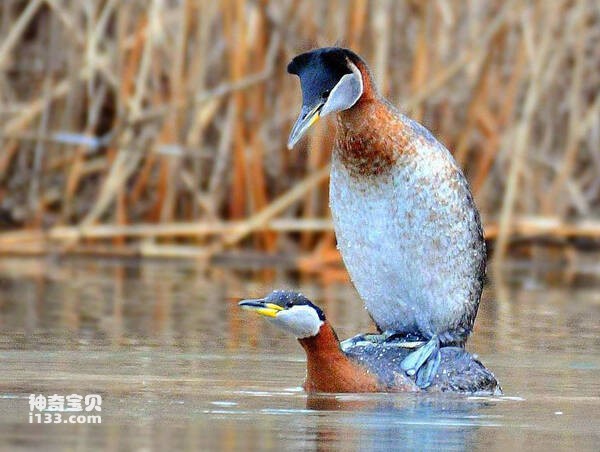Podiceps grisegena
IUCN
LCBasic Information
Scientific classification
- name:Podiceps grisegena
- Scientific Name:Podiceps grisegena,Red-necked Grebe
- Outline:Waterfowl
- Family:
Vital signs
- length:48-56CM
- Weight:About 1kg
- lifetime:No textual research information is available
Feature
The crown and short crest of the summer feather are black, the cheeks and throat are grayish white, and the foreneck, side and upper breast are chestnut red
Distribution and Habitat
The red-necked Grebe is found in Europe, the far north coast of Africa, southwest Asia, eastern Siberia, and western and northern North America.
Native distribution: Afghanistan, Albania, Armenia, Austria, Azerbaijan, Belarus, Belgium, Bosnia and Herzegovina, Bulgaria, Canada, China, Croatia, Czech Republic, Denmark, Estonia, Finland, France, Georgia, Germany, Greece, Hungary, India, Iran, Ireland, Italy, Japan, Kazakhstan, Republic of Korea, Republic of Korea, Kyrgyzstan , Uzbekistan, Latvia, Lithuania, Macedonia, the former Yugoslavia, Moldova, Montenegro, Netherlands, Norway, Pakistan, Poland, Romania, Saint Pierre and Miquelon Islands, Serbia, Slovakia, Slovenia, Spain, Sweden, Switzerland, Tajikistan, Turkey, Turkmenistan, Ukraine, United Arab Emirates, United Kingdom, United States .
Distribution: Algeria, Bahamas, Bermuda, Cyprus, Egypt, Faroe Islands, Greenland, Iceland, Israel, Lebanon, Luxembourg, Portugal, Saudi Arabia, Svalbard and Jan Mayen, Syria, Tunisia.
China
Appearance
Great red necked Grebe has black summer plumage on top, elongated and slightly protruding on both sides of the head, forming a short black crown; The cheeks and throat are grayish white, the front neck and upper chest are chestnut red, the back neck and upper body are grayish brown; Wing edge cover and upper outer wing small cover white, the rest of the upper wing cover gray brown; The primary feathers are grayish brown with black spots, the secondary feathers are white with black tail feathers; Lower thorax and abdomen white, with indistinct grayish markings; White flanks with dark brown ends.
The forehead and head of the winter feather are black, the hindneck and upper body are dark brown, with a grayish-brown feather margin, the underside and behind the eyes are light grayish-brown, and the rest of the head, chin and upper throat are white. The foreneck and side of the neck are brown, the feather tips are slightly grayish white, the rest of the lower body is white, the thorax sid
Details
pit Grebe (scientific name: Podiceps grisegena) foreign language name Red-necked Grebe, there are 2 subspecies in the world, that is, the red-necked grebe named subspecies P. g. Grisegena (Boddaert, 1783) and the Red Necked Grebe Northern subspecies P. g. holboellii (Reinhardt, 1854). China has only a northern subspecies, which breeds in Heilongjiang province and winters in Hebei, Fujian and Guangdong. During the migration, it passed through Jilin and Liaoning provinces. There is also information that the named subspecies also breeds in the Tekos River in China, but this is not confirmed.

The Grebe is found alone or in pairs on the water during the day, and occasionally in small groups, especially during migration. Good at swimming and diving, do not like to fly, even if suddenly faced with danger, but also by diving or swimming to hide in nearby plants to escape danger. Sex alert, action is extremely cautious and careful, more away from the shore activities. It is easier to move on land than a crested grebe, but generally does not go to land. It is aggressive during the breeding season to defend its territory, and when other red-necked grebes intrude, it will resort to underwater diving attacks to drive out intruders.
The Grebe feeds mainly on fish, frogs, tadpoles, insects and their larvae, crustaceans, mollusks and other small aquatic invertebrates and vertebrates, and also eats some aquatic plants. Foraging is mainly through diving, while flying in the air, able to catch some low-altitude insects. The red-necked grebe usually catches and swallows small prey underwater, while bringing larger prey to the surface for consumption. Usually they hold their prey in their beaks and shake their heads to swallow it. Silence outside the breeding season. The nest was noisy, howling "uooh, uooh, uooh..." , ending with a gruff scream; Also makes a gruff cherk call.

The red-necked grebe migrates from March to April in spring and from late September to early October in autumn. Heilongjiang Province of China is a summer migratory bird, and the southern part is a winter migratory bird. They often migrate in pairs or small groups along rivers and coasts. Birds in North America and Northeast Asia overwinter in China, Japan, and the southern United States.
The breeding season for the red-necked grebe is generally from May to July, mid-April to May in Europe and mid-May to June in North America. During reproduction there is often a continuous "kek-kek-kek" frequent call or a wailing "khkh-khaaa-kkhakbaa-kha" call. In courtship, the male and female birds swim together, flap their wings, then raise their forelegs, stand face to face in the water, their beaks touching, their crests upright, and then swim away. From about April onwards, the Grebe begins to move to breeding grounds. Upon arrival, it begins to nest, usually in scattered pairs, about 50 m apart. . They nest in freshwater lakes and ponds rich in aquatic plants such as reeds and rushes. The nest is a floating nest, formed by the accumulation of dead aquatic plants, usually placed in the water grass.

Each clutch lays 4-5 eggs, and there are as few as 3 eggs and as many as 6 or even 8 eggs. The eggs are blue-green when they are first laid and gradually turn rusty brown as they hatch. The size is 47.8-53.5 mm x 33.5-36.8 mm, with an average of 51.5 mm x 35.77 mm. Incubation begins after the first egg is laid, and the incubation period is 20-23 days. Young birds become young. After hatching, the chicks climb onto the back of the parent bird and stay there for about 10 days. After about 2 weeks the chicks are able to move around and dive, and after 7-9 weeks they can fly. The chicks are then fed by their parents for about 54 days before their wings are nearly full.
The red-necked Grebe is extremely rare in China and can only be found in Harbin, Liaodong Peninsula, Hebei and Fujian. According to the survey of Asian midwinter waterbirds organized by the International Waterfowl Research Bureau in 1990 and 1992, there were 1156 in China in 1990 and 574 in 1992. In the rest of East Asia, the number was 575 in 1990. In Asia, only 77 individuals were seen in West Asia and 143 in South Asia in 1992, making the population quite limited. In 2006, Wetlands International estimated the global population of Grebe at 190,000-290,000 individuals. In 2009, population estimates in some countries were as follows: about 10,000-100,000 adult pairs and 1,000-10,000 individual red-necked grebes migrated to China, and about 50-1,000 overwintered in China; Fewer than 100 pairs of adult birds and fewer than 50 individuals have migrated to Japan, and about 1,000-10,000 birds overwinter in Japan; 10,000-100,000 pairs of adult birds and 1,000-10,000 individuals migrated to Russia.

In North America, the red-necked grebe is threatened by ecological pollution such as polychlorinated biphenyls (PCBS) and pesticides, causing its eggs to become sterile and its egg shells to thin, and reducing its successful reproductive rate. Species are also threatened by changes and degradation of lakes, disturbance by human activities (especially recreational activities) and habitat loss (development of agricultural and road land), and may also be threatened by oil spills, although the impact of oil spills is relatively small. In order to protect the red-necked grebe, it is necessary to conduct population surveys in their breeding areas and monitor their breeding numbers. There is also a need to reduce water traffic encroachment on their habitat and disturbance to their populations. Identifying and protecting key sites outside their breeding grounds and investigating their wintering and non-breeding activities will also contribute to conservation.
It has been listed in China's "National Secondary Key Protected Wildlife List" (1988).
It is listed as an endangered species by the Wisconsin Department of Natural Resources.
It is listed on the IUCN Red List of Threatened Species (IUCN) 2018 ver 3.1 - Species not at Risk (LC).
It is listed in the second level of China's National Key Protected Wildlife List (2021).
Protect wild animals and eliminate wild meat.
Maintaining ecological balance is everyone's responsibility!








